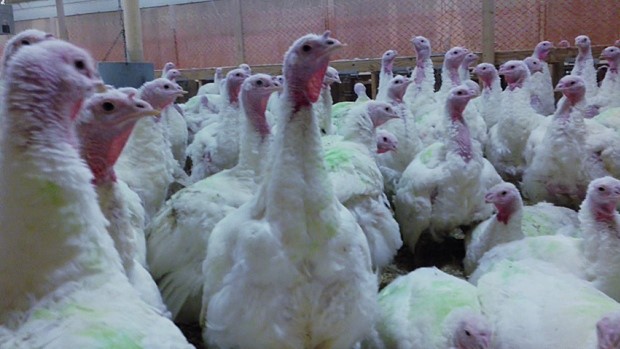How Factory Farmed Animals are Neglected in the Canadian Legal System

Last year, an undercover investigator from Mercy For Animals Canada released footage revealing that the turkeys in a Hybrid Turkeys breeding facility in Bright, Ontario were being clubbed and kicked by employees of the facility, hit with shovels, left with open wounds, and being subjected to what can only be classified as egregious cruelty to animals.
The Ontario Society for the Prevention of Cruelty to Animals (OSPCA) laid eleven charges against the plant, and five of their employees. This was the first set of charges under the Ontario SPCA Act against a factory farm based on footage obtained by undercover workers from an animal protection organization.
Hybrid Turkeys claims that these instances of brutality against animals are isolated events, but time and again, animal protection organizations have opened the door on these companies and shown that where there are factory farms, there is violence. These charges are a step in the right direction for animals, but they beg the following questions: what about the animal abuse that occurs on farms which do not get visits from undercover animal protection groups, or when the undercover footage does not lead to charges, or where the suffering simply falls under the scope of what the law considers to be necessary?
In Canadian factory farms, animals are usually confined in small cages, preventing them from going outside for nearly their entire lives. This confinement prevents animals from carrying out their natural behaviours, and causes serious injury, distress, and overall suffering. Egg-laying hens often live out their whole lives in tiny battery cages, stacked on top of one another. They have their beaks seared off with a hot blade. The unnecessary male chicks are often disposed of, sometimes done by grinding them up alive. Intensive confinement can subject birds, pigs, and cows to injuries and filthy conditions. Milk cows are artificially inseminated, and calves are usually taken away at birth to veal farms, or stay in the dairy industry to produce milk. The gruesome conditions of factory farms, the long hours in tightly-packed transport trucks in brutal weather conditions, the absence of veterinary care, and a general lack of care for individual animals means many animals do not even live to reach the slaughter house. This is a very brief description of only a couple of the species that live out their lives in horrific conditions on industrial farming facilities.
Under Canadian law, animals are, without any legal rights of their own, rendered ‘property.’Because animals’ interests are not prioritized against economic gain, to say their interests are neglected is an understatement. Under the criminal law, animal cruelty laws focus on the “unnecessary suffering” of animals, which basically creates a divide between what acts can and cannot be done to animals like dogs and cats versus those animals that we use for food and other products. When we use animals for products, we tend to see their suffering as “necessary.”Numerous investigations have been released from factory farms, and most of the treatment that has been exposed has not resulted in any legal repercussion, until the Hybrid Turkeys case, despite the conditions being just as shocking in each case.
The content of animal cruelty laws in the Criminal Code have barely changed since 1892, even though society has gained considerable interest in and care for the welfare of animals. Provinces usually have jurisdiction over the conditions animals live in throughout their lives, while federal laws cover transportation and slaughter. While all provinces have animal protection statutes, they usually cover many animals used in a variety of industries, and these laws are often vague and too widely applicable to define and prohibit specific activities. Generally, provincial codes exempt standard practices from being considered offences, and so intensive confinement, castration, and overall lack of care can slip under the radar of the law. There are also codes of conduct to protect animals, but these are usually voluntary.
Animals generally fall subject to the will of the facilities and companies which make a profit off of them. Insufficient enforcement procedures for the very small set of laws that do aim to protect animals means that the suffering of most of the seven hundred million animals that are used for food in Canada every year are hidden from public scrutiny.
In many ways, the current law does not reflect the ways that we have come to care about the suffering of animals, but on the other hand, most of our consumption practices enforce the idea that as long as we cannot see where our food is coming from, it simply doesn’t matter. As the old adage goes: out of sight, out of mind. When whistle blowers like Mercy For Animals Canada reveal the treatment of animals on farms, we all respond in horror, demand that companies change their policies, and ask law enforcement to prosecute those individuals who we see abusing animals. But we need to look beyond these specific cases.We can’t allow companies to use individual employees as scapegoats by claiming they were a bad few in an otherwise humane system. We need to question the entire system of factory farming. If consumers cease to participate in an industry that harms animals, by limiting or cutting out consumption of animal products, we can bring our morality together with practice. We can empower companies and legislators, and force farming practices to accurately reflect the way we care about animal suffering.
